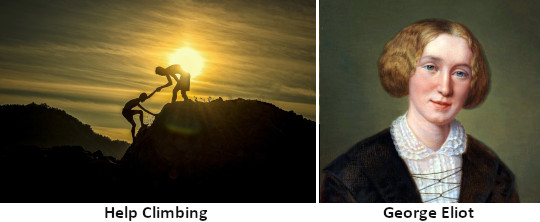George Eliot? Mary Ann Evans? F. O. Hamilton? Apocryphal?

Question for Quote Investigator: George Eliot was a prominent English novelist of the Victorian era. The author’s real name was Mary Ann Evans. The following remark has been ascribed to her:
What do we live for if not to make the world less difficult for each other?
I am having trouble locating this statement within her oeuvre. Would you please help?
Reply from Quote Investigator: The quotation can be found in Eliot’s novel “Middlemarch: A Study of Provincial Life”. Volume four of the work appeared in 1872. The correct phrasing differed from the version specified by the questioner. Emphasis added to excerpts by QI:1
“Mr Lydgate would understand that if his friends hear a calumny about him their first wish must be to justify him. What do we live for, if it is not to make life less difficult to each other? I cannot be indifferent to the troubles of a man who advised me in my trouble, and attended me in my illness.”
The quotation included the additional words “it is”. The word “life” occurred instead of “world”, and the preposition “to” occurred instead of “for”.
Below are additional selected citations in chronological order.
“Middlemarch” was serialized in the New York periodical “Harper’s Weekly” and the quotation appeared in an issue published in February 1873.2
In 1900 the quotation collector Sara A. Hubbard published “Catchwords of Cheer” which presented a different saying for each day of the year. Hubbard included an altered instance of the Eliot statement that matched the modern version given by the questioner:3
FEBRUARY 4.
What do we live for if not to make the world less difficult for each other?
George Eliot.
In 1908 “The Winnipeg Tribune” further disseminated the altered version of the quotation:4
Motto For the Week.
“What do we live for if not to make the world less difficult for each other?”—George Eliot.
In May 1938 a column providing religious guidance included an instance of the saying without attribution. The sentence before the remark was about smiles and scowls. The sentence after the remark was a quip about self-absorbed behavior. A QI article about this latter statement is available here.5
No friends can be made until you have shown that you are a friend. Do not forget you must face your friends after the goods have been delivered. Wear a smile and have friends, wear a scowl and have wrinkles.
What do we live for if not to make the world less difficult for each other. Always remember, a person wrapped up in himself always makes a very small package.
In September 1938 the statement about smiles and scowls was combined with the saying under analysis and both were incorrectly ascribed to George Eliot.6
Wear a smile and have friends; wear a scowl and have wrinkles. What do we live for if not to make the world less difficult for each other?
—GEORGE ELIOT.
In conclusion, George Eliot should receive credit for the words she wrote in the novel “Middlemarch”. By 1900 the statement had been altered and streamlined. The new statement was still attributed to George Eliot. By 1938 an unrelated statement about smiles and frowns had been attached to the modified statement, and both statements were being incorrectly assigned to Eliot.
Image Notes: Illustration of one person helping another person to climb a hill from sasint at Pixabay. Portrait of George Eliot by the Swiss artist Alexandre-Louis-François d’Albert-Durade. Replica made between 1849 and 1886 accessed via Wikimedia Commons. Images have been cropped and resized.
Acknowledgement: Great thanks to Simon Koppel whose inquiry led QI to formulate this question and perform this exploration. Koppel asked about the combined statements in the 1938 citations which continue to circulate today.
Update History: On April 4, 2025 the format of the bibliographical notes was updated.
- 1872, Middlemarch: A Study of Provincial Life by George Eliot, Volume IV, Book VIII: Sunset and Sunrise, Chapter 72, Quote Page 180 and 181, William Blackwood and Sons, Edinburgh. (Google Books Full View) link ↩︎
- 1873 February 1, Harper’s Weekly, Supplement, Middlemarch: A Study of Provincial Life by George Eliot, Volume IV, Book VIII: Sunset and Sunrise, Chapter 72, Quote Page 106, Column 1, Harper & Brothers, New York. (Google Books Full View) link ↩︎
- 1900 Copyright, Catchwords of Cheer, Compiled by Sara A. Hubbard, Date: February 4, Unnumbered Page, Printed for the Publisher, Ralph Fletcher Seymour, by Langworthy & Stevens in Chicago, Illinois. (Internet Archive at achive.org) link ↩︎
- 1908 April 25, The Winnipeg Tribune, Tea Table Talk, Quote Page 14, Column 1, Winnipeg, Manitoba, Canada. (Newspapers_com) ↩︎
- 1938 May 12, The Duncannon Record, Christian Endeavor News by F. O. Hamilton, Quote Page 3, Column 3, Duncannon, Pennsylvania. (Newspapers_com) ↩︎
- 1938 September 22, The Kerrville Times, (Box in upper right corner containing a quotation), Quote Page 1, Column 8, Kerrville, Texas. (Newspapers_com) ↩︎